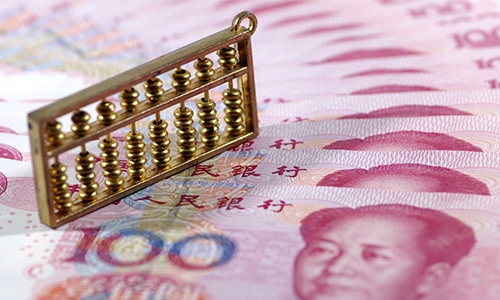
Yuan File photo: VCG
The Chinese central government will issue an additional 1 trillion yuan ($137 billion) in treasury bonds during the fourth quarter, as part of its effort to support post-disaster reconstruction, make up for weakness in disaster prevention and rescue mechanisms, and improve the country's overall resilience to natural disasters.
Observers said that the increase is a timely and pragmatic move in response to dynamic developments in the economy, and it will lay a solid foundation for a sound start of the world's second-largest economy next year.
The extra bonds will be allocated to local governments through transfer payments in a move that is expected to optimize the local debt structure and ease the fiscal burdens of local governments, they noted.
The new issuance is estimated to drive the country's fiscal deficit ratio in 2023 to about 3.8 percent, which is high in historical terms, from the target of 3 percent set at the beginning of the year, the Xinhua News Agency reported. As "special times call for special measures," observers stressed that the move conforms with the country's economic development goals, and China's overall debt level is still significantly lower than that of other major economies.
The amount of 1 trillion yuan was approved by the sixth session of the Standing Committee of the 14th National People's Congress (NPC), China's top legislature, and it has been categorized as special treasury bonds. Half of the quota will be used this year and half in the new year, the Xinhua report said.
The central government issued more than 7.5 trillion yuan in bonds in the first three quarters, according to statistics released by the Ministry of Finance on October 7. According to the Ministry of Finance, the funds will be focused on eight areas, including post-disaster reconstruction, key flood prevention projects, natural disaster emergency response capacity improvement projects as well as high-standard farmland construction in disaster-stricken areas in Northeast China and the Beijing-Tianjin-Hebei region.
Chinese analysts said that the macro move is a precise and targeted stimulus based on the economic situation.
The amount is quite large in comparable terms. In 2020, China issued 1 trillion yuan of special treasury bonds to fund stimulus spending and shore up the economy during the first year of the COVID-19 pandemic. In 2022, the amount was 750 billion yuan.
Tian Yun, a Beijing-based economist, told the Global Times on Tuesday that while China's economy has maintained recovery momentum, issues such as insufficient demand and weak confidence persist. "So the extra bond issuance is conducive to accelerating basic infrastructure construction, shoring up overall demand and boosting market confidence. It will pave the way for the economy to start off on an upbeat note next year," Tian noted.
The adjustment will also provide abundant policy support for economic growth in the fourth quarter of 2023, Hu Qimu, a deputy secretary-general of the digital-real economies integration Forum 50, told the Global Times on Tuesday.
"Although various economic growth targets were achieved in the first three quarters of the year, the further adjustment will generate more market confidence for the coming year, in order to quickly restore a normal economic growth rate," said Hu.
In the third quarter,
China's economy expanded 4.9 percent year-on-year, beating market expectations. The growth was fueled by multiple drivers, including consumption and industrial activity.
China's Ministry of Finance said that as a next step, it will launch the debt issuance in a timely manner, to ensure the task is completed on time. Meanwhile, it will facilitate the local budget allocation to accelerate the formation of real investment.
The Xinhua report said that in connection with the new bond issue, there will be a corresponding adjustment to the central government's budget in 2023. China's fiscal deficit will rise to 4.88 trillion yuan from 3.88 trillion yuan this year, which means that the fiscal deficit ratio would jump to 3.8 percent from 3 percent.
In 2020, China's deficit-to-GDP ratio was 3.7 percent, and the ratio was brought down to 3.1 percent in 2021 and 2.8 percent in 2022.
Analysts said that the adjustment won't lead to any financial risks and China still has plenty of room for policy maneuvers.
The Ministry of Finance said that it will implement a whole-process tracking and monitoring system, to ensure the capital is spent as intended, the Xinhua report said.




